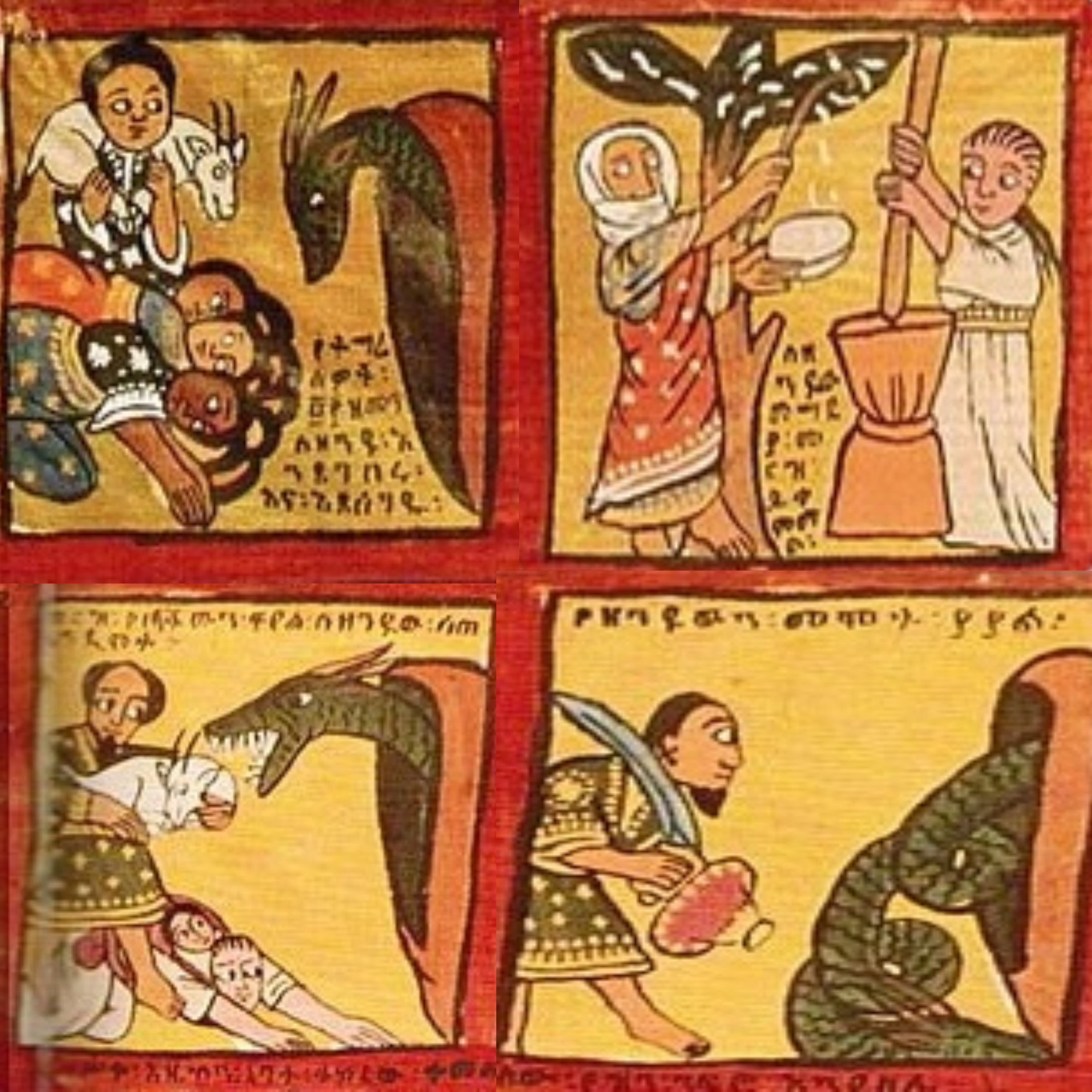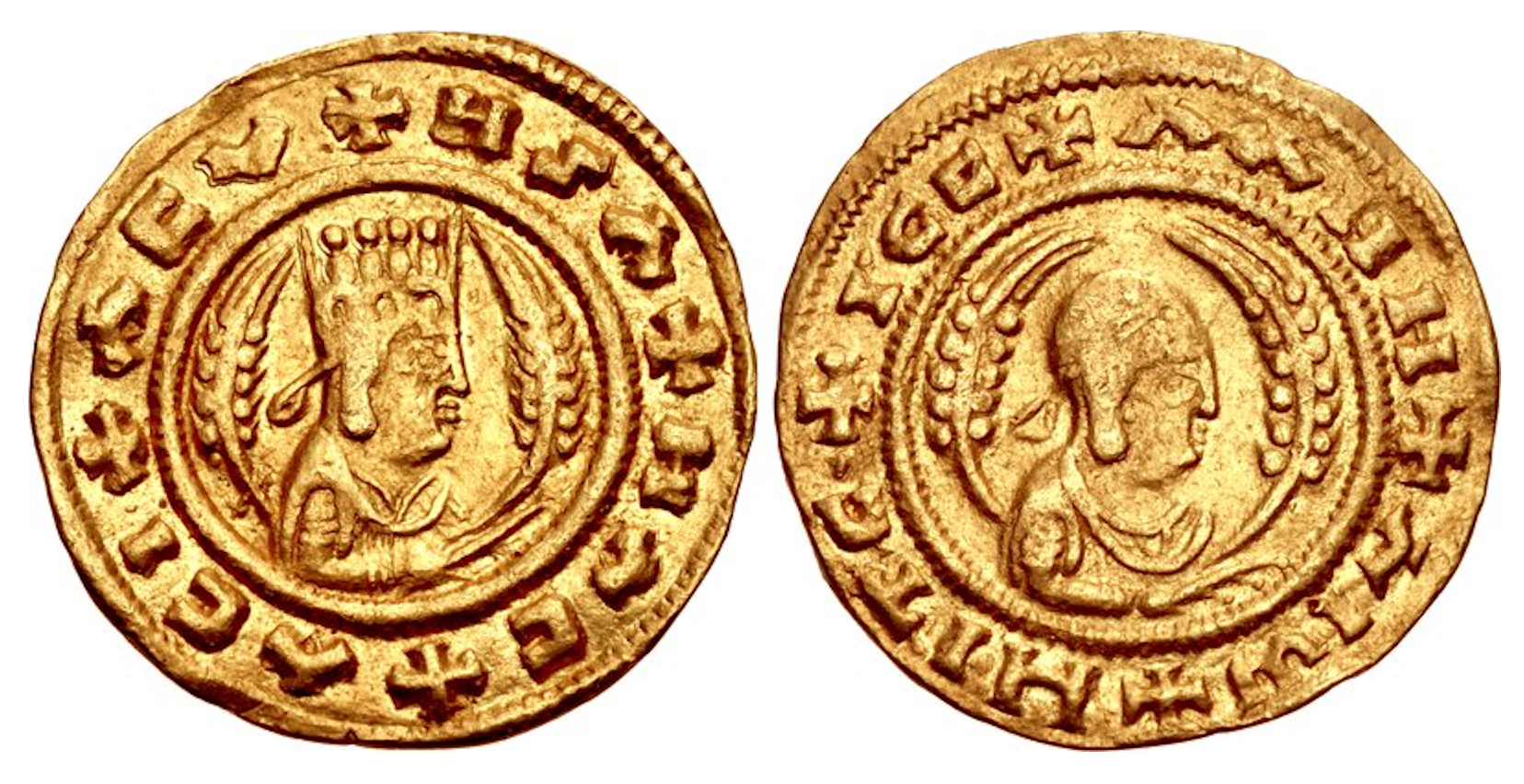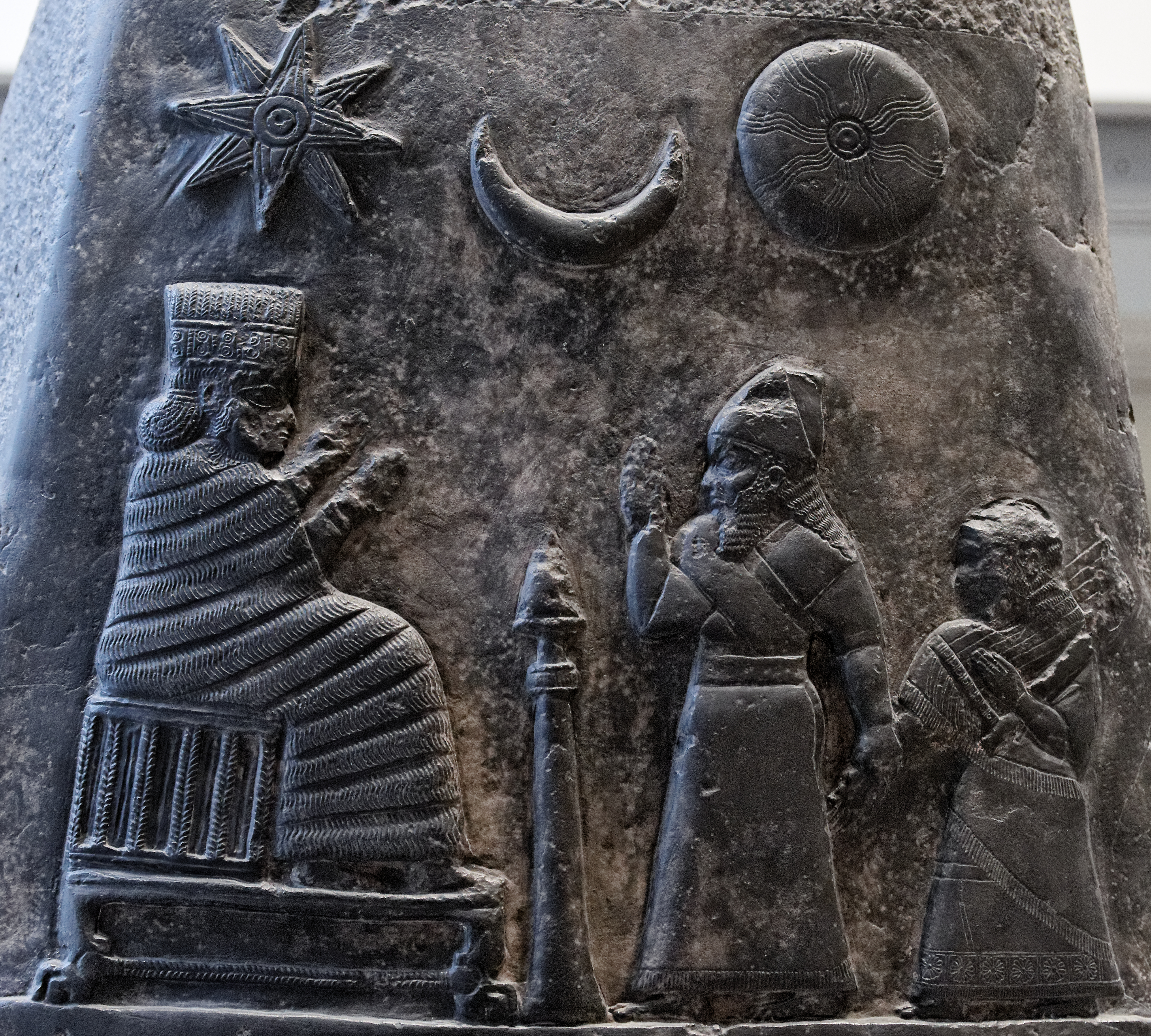|
Ella Amida
Ousanas (fl. 320), known as Ella Allada or Ella Amida in Eritrean and Ethiopian tradition, was the ruler of the Kingdom of Aksum in the 320s AD. Some historians believe that Christianity was introduced into Aksum during his reign. Little is known about his life, but he may have invaded and imposed tribute upon Nubia, and he may have had a "relatively long reign". His reign may have been briefly interrupted by the usurper Wazeba. Stuart Munro-Hay believes that it is "very likely" that Ousanas is the king to whom Aedesius and Frumentius were brought. W.R.O. Hahn, in a study published in 1983, identifies Sembrouthes, who is known only from an inscription found in Daqqi Mahari in modern Eritrea, with Ousanas. If correct, this would give Ousanas a reign of at least 27 years. Axumite regnal lists and alternate names Ethiopian tradition credits Abreha and Atsbeha with being the first Christian kings of the country. They were likely based on the brothers Ezana and Saizana, sons ... [...More Info...] [...Related Items...] OR: [Wikipedia] [Google] [Baidu] |
List Of Kings Of Axum
The kings of Axum ruled an important trading state in the area which is now northern Ethiopia and Eritrea, from 400 BC to 960 AD. Sources Various regnal lists of Axumite monarchs have survived to the present day via manuscripts or oral tradition. However, the lists often contradict each other and many lists contain incomplete or scattered information. The lists were likely compiled over a long period at several different monasteries. Some historians consider these lists to be untrustworthy. There are a number of legendary figures at the beginning of some lists whose historicity is difficult to confirm or trace. Axumite kings may have used multiple names similar to the later Emperors of the Ethiopian Empire (1270–1974), resulting in different names for the same ruler on different lists. Aksumite coins have proven useful for constructing a chronology of Axumite kings. Around 98 percent of the city of Axum has not yet been excavated. At least 18 kings have been identified with ... [...More Info...] [...Related Items...] OR: [Wikipedia] [Google] [Baidu] |
Regnal Lists Of Ethiopia
Regnal lists of Ethiopia are recorded lists of monarchs who are claimed by tradition to have ruled Ethiopian Empire, Ethiopia. These lists are often recorded on manuscripts or Oral tradition, orally by Monastery, monasteries and have been passed down over the centuries. Many surviving physical regnal lists, as well as recorded oral lists, chronicle the line of kings beginning with Menelik I to the Solomonic dynasty. In Ethiopian tradition, Menelik is believed to be the son of queen Makeda (the Biblical canon, Biblical Queen of Sheba) and king Solomon. The rulers that followed Menelik were the List of kings of Axum, kings of Axum, the Zagwe dynasty and the Solomonic dynasty. Some monarchs who ruled before Menelik are recorded in different Ethiopian traditions. These regnal lists were used to prove the longevity of the Ethiopian monarchy and to provide legitimacy for the Solomonic dynasty until its 1974 Ethiopian coup d'état, fall from power in 1974. Traditions Ethiopian tradition ... [...More Info...] [...Related Items...] OR: [Wikipedia] [Google] [Baidu] |
India
India, officially the Republic of India, is a country in South Asia. It is the List of countries and dependencies by area, seventh-largest country by area; the List of countries by population (United Nations), most populous country since 2023; and, since its independence in 1947, the world's most populous democracy. Bounded by the Indian Ocean on the south, the Arabian Sea on the southwest, and the Bay of Bengal on the southeast, it shares land borders with Pakistan to the west; China, Nepal, and Bhutan to the north; and Bangladesh and Myanmar to the east. In the Indian Ocean, India is near Sri Lanka and the Maldives; its Andaman and Nicobar Islands share a maritime border with Thailand, Myanmar, and Indonesia. Modern humans arrived on the Indian subcontinent from Africa no later than 55,000 years ago., "Y-Chromosome and Mt-DNA data support the colonization of South Asia by modern humans originating in Africa. ... Coalescence dates for most non-European populations averag ... [...More Info...] [...Related Items...] OR: [Wikipedia] [Google] [Baidu] |
Archaeological Site
An archaeological site is a place (or group of physical sites) in which evidence of past activity is preserved (either prehistoric or recorded history, historic or contemporary), and which has been, or may be, investigated using the discipline of archaeology and represents a part of the archaeological record. Sites may range from those with few or no remains visible above ground, to buildings and other structures still in use. Beyond this, the definition and geographical extent of a "site" can vary widely, depending on the period studied and the theoretical approach of the archaeologist. Geographical extent It is almost invariably difficult to delimit a site. It is sometimes taken to indicate a settlement of some sort, although the archaeologist must also define the limits of human activity around the settlement. Any episode of deposition, such as a hoard or burial, can form a site as well. Development-led archaeology undertaken as cultural resources management has the disad ... [...More Info...] [...Related Items...] OR: [Wikipedia] [Google] [Baidu] |
Aksumite Currency
Aksumite currency was coinage produced and used within the Kingdom of Aksum (or Axum) centered in present-day Ethiopia and Eritrea. Its mintages were issued and circulated from the reign of King Endubis around AD 270 until it began its decline in the first half of the 7th century where they started using Dinar along with most parts of the Middle East. During the succeeding medieval period, Mogadishu currency, minted by the Sultanate of Mogadishu, was the most widely circulated currency in the eastern and southern parts of the Horn of Africa from the start of the 12th century. Aksum's currency serves as an indicator of the kingdom's contemporary cultural influences and religious climate (first polytheistic and later Oriental Christianity). It also facilitated the Red Sea trade on which it thrived.Stuart Munro-Hay, ''Aksum: An African Civilization of Late Antiquity'' (Edinburgh: University Press, 1991), p. 155. The coinage has also proved invaluable in providing a reliable ch ... [...More Info...] [...Related Items...] OR: [Wikipedia] [Google] [Baidu] |
Sin (mythology)
Sin () or Suen (, ) also known as Nanna ( ) is the Mesopotamian god representing the moon. While these two names originate in two different languages, respectively Akkadian language, Akkadian and Sumerian language, Sumerian, they were already used interchangeably to refer to one deity in the Early Dynastic Period (Mesopotamia), Early Dynastic period. They were sometimes combined into the double name Nanna-Suen. A third well attested name is Dilimbabbar (). Additionally, the name of the moon god could be represented by logograms reflecting his lunar character, such as d30 (), referring to days in the lunar month or dU4.SAKAR (), derived from a term referring to the crescent. In addition to his astral role, Sin was also closely associated with cattle herding. Furthermore, there is some evidence that he could serve as a judge of the dead in the Ancient Mesopotamian underworld, underworld. A distinct tradition in which he was regarded either as a god of equal status as the usual hea ... [...More Info...] [...Related Items...] OR: [Wikipedia] [Google] [Baidu] |
Shams (deity)
Shams, also called or ''Shamsum'' or ''Dhat-Ba' dhanum'', is a sun goddess of Arabian mythology. She was the patron goddess of the Himyarite Kingdom. Her name meant 'shining', 'Sun', or 'brilliant'. She was the South Arabian equivalent of the North Arabian sun goddess Nuha. Prior to Islam, religion on the Arabian Peninsula focused on local gods, with every tribe and kingdom having their particular protective deities. However, there were also gods common for all Arabs, and the trinity of gods representing the Sun, the Moon and the planet Venus seem to have been worshipped throughout Arabia, though their names, gender and worship differed between regions. Thus, Nuha was the name of the sun goddess in Northern Arabia, while the name of the sun goddess in Southern Arabia was Shams. As Nuha, Shams was also worshipped in a trinity alongside the male gods of the Moon and Venus. In Saba', the sun goddess Shams was worshipped with the god of the planet Venus, Athtar, and Almaqah, ... [...More Info...] [...Related Items...] OR: [Wikipedia] [Google] [Baidu] |
James Bruce
James Bruce of Kinnaird (14 December 1730 – 27 April 1794) was a Scottish traveller and travel writer who physically confirmed the source of the Blue Nile. He spent more than a dozen years in North and East Africa and in 1770 became the first European to trace and document the course of the Nile by following it upstream from Egypt through Sudan to its origins in the Blue Nile in Ethiopia. Early life James Bruce was born at the family seat of Kinnaird, Stirlingshire, and educated at Harrow School and Edinburgh University. He began to study for the bar, but his marriage to the daughter of a wine importer and merchant resulted in him entering that business instead. His wife died in October 1754, within nine months of marriage, and Bruce thereafter travelled in Portugal and Spain as part of the wine trade. The examination of oriental manuscripts at the Escorial in Spain led him to the study of Arabic and Geʽez and determined his future career. In 1758, his father's death ... [...More Info...] [...Related Items...] OR: [Wikipedia] [Google] [Baidu] |
Church Of Abreha Wa-Atsbeha
The Church of Abreha wa-Atsbeha (sometimes spelt Abreha we Atsbeha) was built in East Tigray, around 15 km from Wukro, in the 4th century by Abreha and Atsbeha. Their bodies are claimed to be entombed in the church. At one time the church served as a monastery but now operates as a parish church. Paul B. Henze visited the church in the 1970s where he was told the ceiling was blackened by soot due to Queen Gudit Gudit () is the Classical Ethiopic name for a personage also known as Yodit in Tigrinya, and Amharic, but also Isato in Amharic, and Ga'wa in Ţilţal. The person behind these various alternative names is portrayed as a powerful female rul ... setting a fire in the building nine centuries earlier. References Churches in Ethiopia History of Christianity in Ethiopia {{Ethiopia-church-stub ... [...More Info...] [...Related Items...] OR: [Wikipedia] [Google] [Baidu] |
Carlo Conti Rossini
Carlo Conti Rossini (1872–1949) was an Italian orientalist. He was director of the State Treasury from 1917 to 1925, a member of the Accademia dei Lincei in 1921 and Royal Academy of Italy from 1939. He wrote various works on the historical geography of Ethiopia, of which the most famous is ''Italia ed Etiopia dal trattato di Uccialli alla battaglia d'Adua'' (''Italy and Ethiopia from the Treaty of Uccialli to the Battle of Adwa'', 1935). He also wrote articles on phonetic Ethiopian (Tigrinya Language Tigrinya, sometimes romanized as Tigrigna, is an Ethio-Semitic languages, Ethio-Semitic language, which is a subgrouping within the Semitic languages, Semitic branch of the Afroasiatic languages. It is primarily spoken by the Tigrinya people, ..., 1940). His library is preserved in Rome. References External links CONTI ROSSINI, Carloin Dizionario Biografico degli Italiani – Volume 28 (1983) Scheda biografica cartografi – DISCIUniversità di Bergamo. 1872 bir ... [...More Info...] [...Related Items...] OR: [Wikipedia] [Google] [Baidu] |
William Bulmer (printer)
William Bulmer (1757–1830) was an English printer and typographer. Biography William Bulmer was born in 1757 as one of the youngest children of Thomas Bulmer in Newcastle-upon-Tyne. He was apprenticed to the printer Mr. Thompson, at Burnt House Entry, St. Nicholas' Churchyard. During his apprenticeship he formed a friendship with Thomas Bewick, which lasted throughout his life When William Bulmer first came to London, he worked for the printer and publisher John Bell and was introduced to George Nicol, bookseller to King George III, who, with John Boydell had conceived a lavish edition of the works of Shakespeare with illustrations from the foremost artists of the day. For the project Nicol had already engaged the services of William Martin, a type-founder from Birmingham who had worked for John Baskerville, to design and cut the type. In the spring of 1790, William Bulmer established The Shakespeare Press at 3 Russell Court, off Cleveland Row, St. James's and the firs ... [...More Info...] [...Related Items...] OR: [Wikipedia] [Google] [Baidu] |
Ethiopian Calendar
The Ethiopian calendar (; ; ), or Geʽez calendar (Geʽez: ; Tigrinya: , ) is the official state civil calendar of Ethiopia and serves as an unofficial customary cultural calendar in Eritrea, and among Ethiopians and Eritreans in the diaspora. It is also an ecclesiastical calendar for Ethiopian Christians and Eritrean Christians belonging to the Orthodox Tewahedo Churches ( Ethiopian Orthodox Tewahedo Church and Eritrean Orthodox Tewahedo Church), Eastern Catholic Churches ( Eritrean Catholic Church and Ethiopian Catholic Church), and Protestant Christian P'ent'ay (Ethiopian-Eritrean Evangelical) Churches. The Ethiopian calendar is a solar calendar that has much in common with the Coptic calendar of the Coptic Orthodox Church of Alexandria and Coptic Catholic Church, but like the Julian calendar, it adds a leap day every four years without exception, and begins the year on 11 or 12th of September in the Gregorian calendar (from 1900 to 2099). A gap of seven to ei ... [...More Info...] [...Related Items...] OR: [Wikipedia] [Google] [Baidu] |






